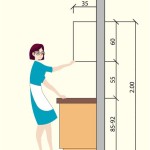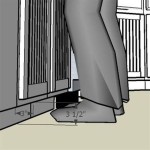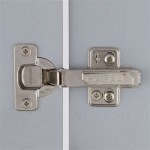How To Get Rid Of Tiny Black Bugs In Kitchen Cupboards
Discovering tiny black bugs in kitchen cupboards can be a disconcerting experience. These pests are not only unsightly but can also contaminate food supplies and potentially spread diseases. Identifying the type of bug is crucial for implementing effective removal strategies. Common culprits include pantry weevils, grain beetles, and ants, each with unique characteristics and behaviors. Once the bug is identified, a multi-faceted approach involving cleaning, eliminating food sources, and employing various pest control methods will be necessary to eradicate the infestation.
Identifying the Culprit: Types of Tiny Black Bugs
Accurate identification of the tiny black bugs infesting kitchen cupboards is the first step in developing a targeted elimination plan. Several species commonly invade these spaces, each with distinct features and habits that influence the eradication approach.
Pantry Weevils: These small, dark insects are typically found in stored grains, cereals, and dried goods. They are characterized by their elongated bodies and snouts, which they use to bore into grains and lay eggs. The larvae then develop inside the grain, consuming it from within. Common types of pantry weevils include rice weevils and granary weevils. Their presence often indicates infested food products that need immediate removal.
Grain Beetles: Several species of grain beetles can infest kitchen cupboards, including the saw-toothed grain beetle, the merchant grain beetle, and the confused flour beetle. These beetles are small, flat, and reddish-brown to dark brown in color. They infest a wide range of stored foods, including flour, cereals, pasta, dried fruits, and nuts. Grain beetles are often attracted to damaged or broken grains and can rapidly multiply in favorable conditions. Unlike weevils, they don't typically bore into whole grains; instead, they feed on already damaged or processed food.
Ants: Certain species of ants, such as the odorous house ant and the pavement ant, are attracted to the sweet and sugary substances often found in kitchens. While they are not exclusively cupboard pests, they can frequently be found foraging for food within these spaces. Ants are easily identified by their segmented bodies, antennae, and social behavior. They often travel in trails, making it easier to track their source and entry points.
Drugstore Beetles and Cigarette Beetles: These beetles are small, oval-shaped, and brownish-black. They are known for their ability to infest a wide variety of dried products, including spices, herbs, pet food, and even prescription drugs (hence the name "drugstore beetle"). They can bore through packaging, making them a particularly challenging pest to control.
Distinguishing between these bugs is crucial. Weevils generally indicate infested grains, while grain beetles suggest broader contamination of dried goods. Ants necessitate tracing their entry points and eliminating their food source. Drugstore and cigarette beetles require a thorough inspection of less obvious dried goods, including those in tightly sealed containers.
Eliminating Food Sources and Thorough Cleaning
One of the most critical steps in removing tiny black bugs from kitchen cupboards is eliminating their food source and thoroughly cleaning the infested area. Without a readily available food supply, the bugs will be less likely to remain and reproduce.
Inspection and Disposal: Begin by meticulously inspecting all food items stored in the affected cupboards. Pay close attention to grains, cereals, flour, pasta, dried fruits, nuts, spices, and pet food. Look for signs of infestation, such as live bugs, larvae, webbing, or damaged packaging. Any food item suspected of being infested should be immediately discarded in a sealed trash bag and removed from the house. Do not simply throw infested items into the kitchen trash can, as this can allow the bugs to escape and re-infest the area.
Thorough Cleaning: After removing all food items, thoroughly clean the inside of the cupboards. Use a vacuum cleaner with a hose attachment to remove any loose crumbs, debris, and dead bugs. Pay particular attention to corners, crevices, and seams, where bugs and their eggs may be hidden. After vacuuming, wipe down all surfaces with a solution of hot, soapy water. For stubborn stains or areas with heavy infestation, use a disinfectant cleaner. Ensure that all surfaces are completely dry before replacing any food items.
Cleaning Spills Promptly: Preventing future infestations requires vigilant attention to cleaning up spills and crumbs. Immediately clean up any food spills or crumbs in the kitchen, especially in areas where food is prepared or stored. Regularly sweep or vacuum the floor to remove any food particles that may attract bugs.
Refrigerator Cleaning: Extend cleaning efforts to the refrigerator. Remove and discard any expired or spoiled food. Wipe down shelves and drawers with a solution of baking soda and water to neutralize odors and prevent mold growth. Clean the refrigerator's drip pan regularly to prevent the accumulation of moisture and bacteria, which can attract insects.
Pantry Organization: Proper organization can also deter pests. Store food in airtight containers made of glass, metal, or sturdy plastic. This prevents bugs from accessing the food and also allows for easier inspection of contents. Rotate food items regularly, using older items first to prevent them from expiring and becoming potential breeding grounds for pests.
Pest Control Methods: Natural and Chemical Options
Once the source of the infestation has been eliminated and the area thoroughly cleaned, implementing pest control methods becomes crucial to ensure the complete eradication of the bugs. Both natural and chemical options are available, with the choice depending on the severity of the infestation and personal preferences.
Natural Pest Control Methods: These methods are generally safer for use around food and pets and can be effective for mild infestations.
Diatomaceous Earth (DE): This natural powder is made from fossilized algae and is a highly effective insecticide. It works by dehydrating insects upon contact. Sprinkle a thin layer of food-grade diatomaceous earth in the corners of the cupboards, along the edges, and in any cracks or crevices where bugs may be hiding. Be sure to use food-grade DE, as other types can be harmful if ingested.
Bay Leaves: Placing bay leaves in cupboards and containers of stored food is a natural repellent for many insects, including pantry weevils and grain beetles. The strong scent of bay leaves deters bugs from entering the area.
Vinegar: White vinegar is a natural cleaning agent and disinfectant that can also kill bugs. Wipe down cupboards with a solution of equal parts white vinegar and water.
Essential Oils: Certain essential oils, such as peppermint, eucalyptus, and tea tree oil, have insect-repelling properties. Dilute a few drops of essential oil in water and spray it around the cupboards.
Freezing: Suspected infested food items can be placed in the freezer for at least 72 hours to kill any bugs or larvae present.
Chemical Pest Control Methods: These methods are typically more effective for severe infestations but require caution and should be used according to the manufacturer's instructions.
Insecticide Sprays: Choose an insecticide spray specifically labeled for use in kitchens and pantries. Apply the spray to cracks, crevices, and other areas where bugs may be hiding. Be sure to remove all food items and dishes from the area before spraying and allow the spray to dry completely before replacing them.
Insecticide Baits: Ant baits can be effective for controlling ant infestations. Place ant baits near ant trails or entry points. The ants will carry the bait back to their colony, eventually killing the entire colony.
Residual Insecticides: These insecticides leave a residue that can kill bugs upon contact for an extended period. They are typically used in areas where bugs are known to travel.
Professional Pest Control: For severe infestations that are difficult to control with DIY methods, consider hiring a professional pest control service. A professional pest control technician can identify the specific type of bug and recommend the most effective treatment plan.
Regardless of the chosen method, consistent monitoring is crucial. Regularly check the cupboards for any signs of re-infestation. If bugs reappear, repeat the cleaning and pest control steps as necessary. Prevention is key to keeping kitchen cupboards bug-free. By maintaining a clean and organized pantry, storing food properly, and regularly inspecting for signs of infestation, it is possible to prevent future outbreaks of tiny black bugs.

6 Tiny Black Bugs In Kitchen Cupboards

6 Tiny Black Bugs In Kitchen Cupboards

6 Tiny Black Bugs In Kitchen Cupboards

Common Kitchen Insects How To Get Rid Of Bugs

How To Get Rid Of The Most Common Pantry Pests

14 Types Of Kitchen Bugs With Pictures Identification Guide

Tiny Black Bugs In Kitchen Cupboards What To Do Next School Of

Tiny Black Bugs In Kitchen 10 Ways To Eliminate Them

Our Experts Share Their Top Tips On How To Get Rid Of Pantry Bugs

9 Tiny Black Bugs On Kitchen Countertops
Related Posts








